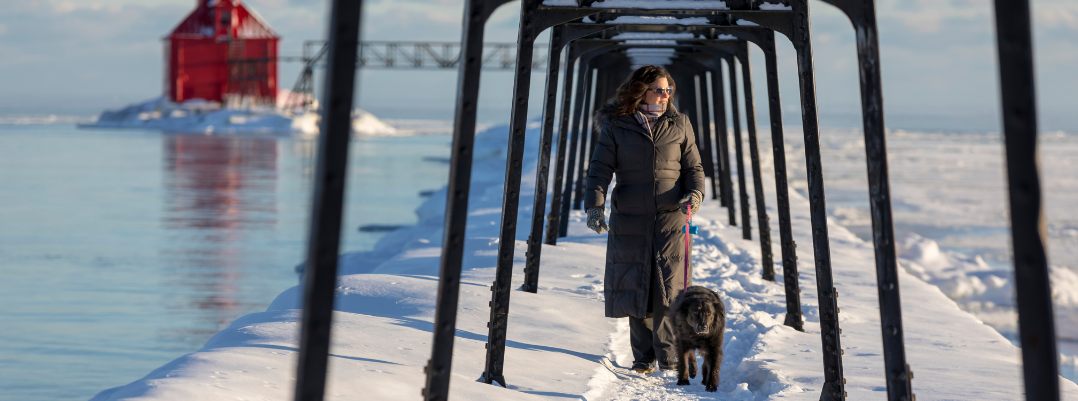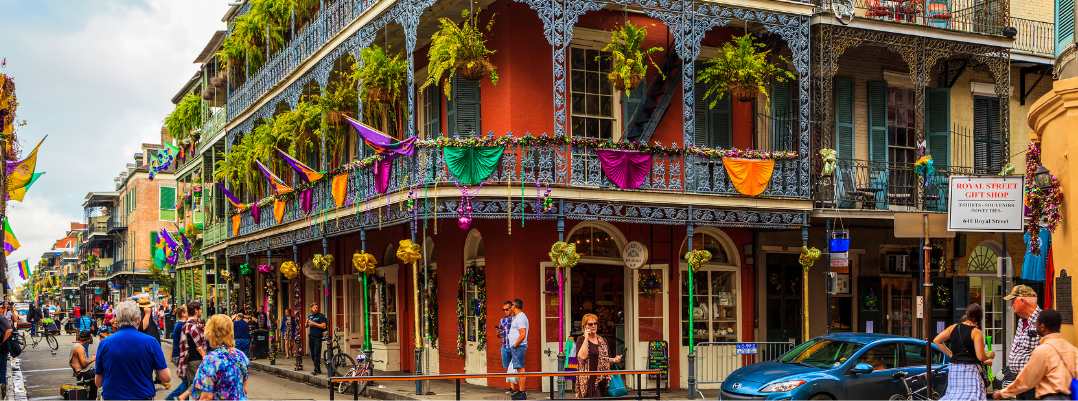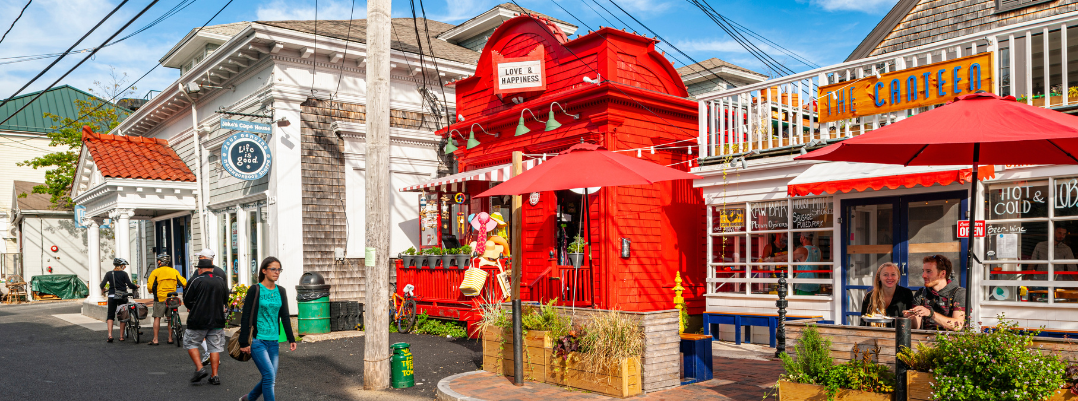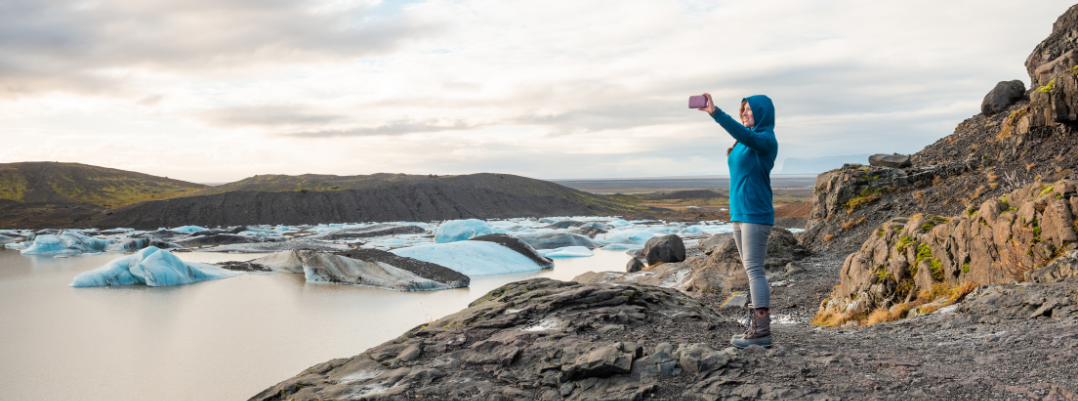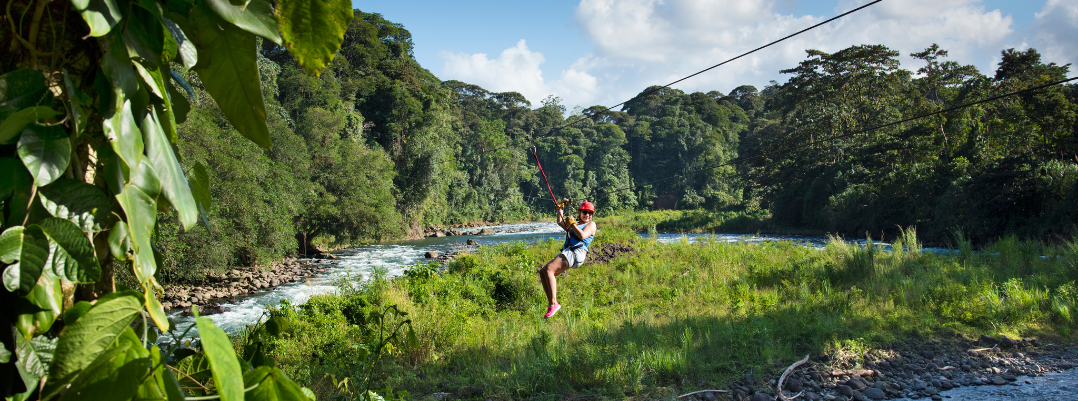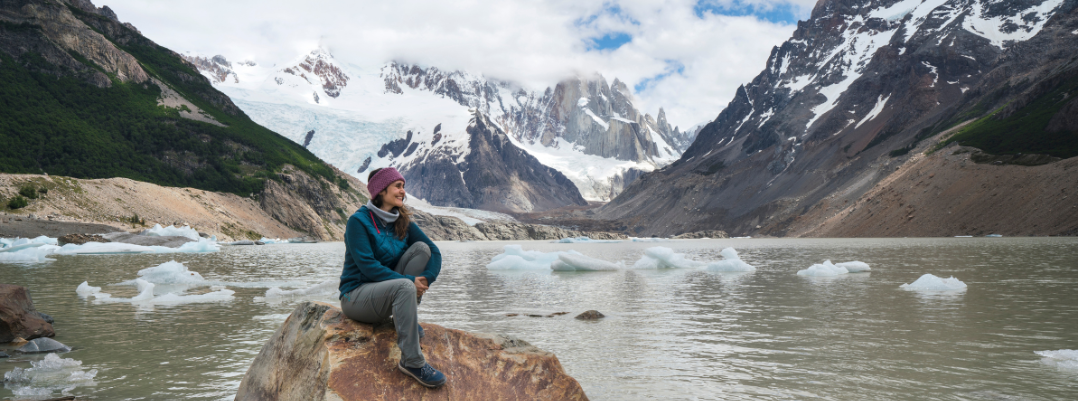The United States is a land of sweeping landscapes, iconic cities, and endlessly diverse experiences. From the red rock canyons of the Southwest to the quiet charm of New England towns, our vast country offers something unforgettable around every corner.
Before you cruise down Highway 1 in California, hike through the Great Smoky Mountains, or catch live jazz in New Orleans, dive into our United States travel guide. You’ll find tips on the best time to visit the United States, what to do, and where to stay — so you can make the most of your next adventure right here at home.
Jump to:
- Essential destination information
- Best time to visit the United States
- Top travel destinations in the U.S.
- What to eat in the U.S.
- The best way to see the country
- Where to stay in the U.S.: top accommodation options
- Packing tips for traveling in the United States
Essential information about the United States
Getting ready to explore more of the U.S.? Just because you're not crossing international borders doesn't mean you won’t need a few helpful travel insights. From regional rules to national park passes to weather patterns, there’s plenty to consider when planning a trip across our diverse country. Here’s what to know before you pack your bags and hit the road — whether you're tackling your United States travel bucket list or trying to visit all 50 states.
Regional weather patterns The geography of America covers a wide range of climates, and conditions can vary drastically depending on where — and when — you travel. The Northeast sees snowy winters and crisp falls, the South brings humidity and hurricane season, and the West ranges from desert heat to alpine snow. Check the local forecast and pack accordingly, especially if you're traveling through multiple regions. | National park access National parks are a highlight of domestic travel, but planning ahead is key. Many parks require reservations for entry, camping, or popular hikes — especially in summer. If you're visiting multiple parks, consider buying the America the Beautiful pass to save on entrance fees. Wondering which state has the most national parks? California — with nine! It’s the perfect place to use your park pass. For more options, check out the full national parks list. | State sales tax differences Sales tax isn’t the same everywhere. States like Oregon, Delaware, and New Hampshire have no sales tax at all, while others — like California and Louisiana — have some of the highest rates in the U.S. Since tax can also vary by city or county, be sure to factor it in when budgeting. Pro tip: If you’re looking for cheap places to visit in the USA, consider exploring small towns or off-season destinations where your dollar goes further. | Driving laws by state Most U.S. driving laws are consistent, but some vary by state — and it’s worth knowing them before you go. Speed limits, cellphone use, toll roads, and right-on-red laws can differ. Some states have stricter seatbelt, car seat, or open container rules. If you’re renting a car, review local laws ahead of time and carry your license, insurance, and rental agreement. |
Accessibility info The Americans with Disabilities Act (ADA) ensures accessibility across the U.S., but actual access can vary. National parks, transit systems, and major attractions are often ADA-compliant, while older buildings and rural areas may be less so. Check ahead for wheelchair access, elevator availability, and service animal policies to avoid surprises. | Traveling with pets Bringing a furry friend along? Many hotels, vacation rentals, and national parks are pet-friendly — but rules vary by location. Airlines have specific policies based on breed, size, and carrier type, and some states or counties have leash laws or breed restrictions. Always call ahead, carry vaccination records, and research pet-friendly stops along your route. | Popular road trip routes The U.S. is made for road trips — with iconic routes from coast to coast. Drive California’s Highway 1, Route 66, the Blue Ridge Parkway, Florida’s Overseas Highway, Utah’s Scenic Byway 12, or the Great River Road along the Mississippi. Plan ahead for gas, food, and lodging to keep the journey smooth — and fun. | Real I.D. requirements Starting May 7, 2025, U.S. travelers will need a Real ID to board domestic flights and enter certain federal buildings. A Real ID looks like a standard driver’s license but includes a star in the upper corner. If your ID doesn’t have it, you’ll need to bring a passport or update your license through your state’s DMV before you fly. |
Best time to visit the United States
The best time to visit the United States depends on what kind of experience you're after. To kick off our United States travel guide, let’s break it down by season to help you plan your next adventure.
If you're drawn to long days, outdoor festivals, and road trip weather, summer opens up a world of possibilities. It’s one of the best times to tackle your U.S. bucket list, from hiking in national parks to exploring vibrant cities. Autumn brings a short but breathtaking display of changing leaves, especially in the Northeast and Midwest. If snow-covered mountains, cozy towns, or winter sports are more your style, the cooler months from November to April offer unforgettable escapes. And for those who prefer fewer crowds and a slower pace, the shoulder seasons provide milder weather and space to breathe — perfect for checking off lesser-known places to travel in the U.S. without the rush.
Whether you're chasing summer sunsets, fall foliage, or peaceful winter landscapes, there's a time and place in the U.S. that suits your travel style.
Seasons in the United States:
High season Summer is ideal for outdoor adventures and lively cities. National parks like Yellowstone and Grand Teton are in full bloom, Cape Cod’s beaches buzz with activity, and cities like Seattle and Chicago come alive with festivals. It’s a popular time to travel, so expect crowds and higher prices — but also long days and countless opportunities to see some of the most iconic travel destinations the U.S. has to offer. | Low season Winter, from November to April, offers a different kind of escape. Ski towns like Aspen and Park City thrive during this time, while New York City dazzles with holiday lights and indoor attractions. For warm-weather seekers, Palm Springs and Key West are top picks — and can even be cheap places to visit in the U.S. during shoulder weeks. Slower travel periods often come with better deals and quieter streets, making this season ideal for a more relaxed getaway. | Shoulder seasons Spring and fall are perfect for travelers seeking quieter experiences and milder weather. Cherry blossoms bloom in Washington, D.C. in April, while October brings vibrant foliage to New England and crisp hikes in the Great Smoky Mountains. Santa Fe is a standout in both seasons, offering art markets and desert calm. If you’re looking for places to go without a passport and want fewer crowds, shoulder seasons are often the best way to see the country at your own pace. |
Best time to visit the United States: 10 seasonal festivals
One of the best ways to explore the country is through its festivals — from music and food to culture and the arts. Throughout the year, cities and small towns across the U.S. host events that bring people together and reflect the country’s regional diversity.
Let’s dive further into our United States travel guide, discovering seasonal festivals that make every time of year worth traveling for:
1. Sundance Film Festival — Park City, Utah
Every January, Park City transforms into the epicenter of independent film. Sundance draws filmmakers, celebrities, and movie lovers from around the world. The snow-covered setting adds a magical touch to this world-renowned event.
2. Mardi Gras — New Orleans, Louisiana
Held in February, Mardi Gras is one of the most iconic festivals in the U.S. with its colorful parades, lively street performances, and deeply rooted Creole traditions. It’s a city-wide celebration like no other.
3. National Cherry Blossom Festival — Washington, D.C.
Held from late March to early April, this festival celebrates the bloom of thousands of cherry trees gifted by Japan. Expect cultural performances, parades, and scenic strolls through the National Mall under a canopy of pink blossoms.
4. Spoleto Festival USA — Charleston, South Carolina
Each May, Charleston hosts one of the nation’s premier performing arts festivals. From opera and theater to jazz and dance, Spoleto brings global talent to a historic Southern setting.
5. Bonnaroo Music & Arts Festival — Manchester, Tennessee
This multi-day camping and music festival in June is a favorite among festival goers. With a wide-ranging lineup of artists, immersive art installations, and a laid-back vibe, Bonnaroo captures the spirit of summer in the South.
6. Telluride Bluegrass Festival — Telluride, Colorado
This beloved June festival combines world-class bluegrass and folk music with stunning Rocky Mountain views. With its intimate setting and loyal following, it’s a favorite among travelers looking for a scenic and soulful summer escape.
7. Newport Folk Festival — Newport, Rhode Island
Held each July in a historic coastal setting, this legendary festival has hosted major acts since 1959 — including Bob Dylan’s iconic electric debut. It’s a must-visit for music lovers looking for a relaxed, intimate summer experience by the water.
8. Lollapalooza — Chicago, Illinois
Set in Grant Park each August, Lollapalooza is a massive multi-day festival that draws global headliners and thousands of fans to Chicago’s lakefront. It’s a celebration of music, art, and youth culture in the heart of the city.
9. Albuquerque International Balloon Fiesta — Albuquerque, New Mexico
Every October, the skies above Albuquerque fill with hundreds of colorful hot air balloons. It’s one of the most photographed festivals in the world and a breathtaking way to welcome autumn.
10. Austin City Limits Music Festival — Austin, Texas
Held over two weekends in October, this festival features major artists across multiple genres in Zilker Park. It’s a great time to enjoy Austin’s live music scene, local food trucks, and Texas hospitality.
Top travel destinations in the U.S.
From coast to coast, the United States is packed with iconic destinations, jaw-dropping landscapes, and unforgettable cultural experiences. Whether you're dreaming of red rock canyons, bustling cityscapes, or coastal getaways, this United States travel guide will help you discover some of the country's most remarkable places.
So, buckle up as we take you on a virtual tour of top destinations to travel to in the USA — and inspire your next great adventure!
Top travel destinations in the U.S.: 10 iconic spots
1. Grand Canyon, Arizona
No list of top U.S. destinations is complete without the Grand Canyon. Its vast, layered rock formations and dramatic viewpoints draw millions each year. For a closer look, hike down the Bright Angel Trail or take a helicopter tour above the Colorado River.
2. New York City, New York
From the Statue of Liberty to Central Park, Times Square to Broadway, New York offers endless things to see and do. The city is a cultural powerhouse and a must-visit for first-time and seasoned travelers alike.
3. Yosemite National Park, California
Located in the Sierra Nevada, Yosemite is known for its towering granite cliffs, waterfalls, and ancient sequoias. It’s one of the most photographed national parks in the country — and surprisingly a cheap place to visit in the U.S. if you plan ahead and camp.
4. Charleston, South Carolina
With cobblestone streets, antebellum architecture, and a thriving food scene, Charleston blends Southern charm with historic depth. Take a walking tour or hop on a horse-drawn carriage for a step back in time.
5. Zion National Park, Utah
Zion’s red rock canyons and slot-carved landscapes offer some of the most dramatic views in the Southwest. Hike the Narrows or Angels Landing for an adrenaline-filled adventure in one of the top nature travel destinations the U.S. has to offer.
6. Chicago, Illinois
Set along Lake Michigan, Chicago impresses with world-class museums, deep-dish pizza, stunning architecture, and iconic events like Lollapalooza. The city balances big-city energy with Midwestern friendliness.
7. Savannah, Georgia
Spanish moss, historic homes, and riverfront charm make Savannah a favorite for slow-paced travel. It’s walkable, romantic, and full of quirky haunts — ideal for a long weekend or road trip stop.
8. Maui, Hawaii
For tropical beauty and volcanic landscapes, Maui is a dream. Drive the Road to Hana, catch sunrise at Haleakalā, or simply relax on its golden beaches.
9. Washington, D.C.
Packed with free museums, national monuments, and historical sites, D.C. is both educational and inspiring. Spring is especially popular when cherry blossoms bloom around the Tidal Basin.
10. Sedona, Arizona
Red rock formations, energy vortexes, and desert hikes make Sedona a unique blend of nature and spirituality. It’s also a more budget-friendly escape if you camp, making it another one of the most stunning yet cheap places to visit in the U.S.
Top travel destinations in the U.S.: 10 hidden gems
1. Silver Falls State Park, Oregon
Known as the “crown jewel” of Oregon’s state parks, Silver Falls offers lush forest trails and the famous Trail of Ten Falls, where you can walk behind cascading waterfalls — a must for any nature lover following our United States travel guide.
2. Great Basin National Park, Nevada
Far from the bustle of Las Vegas, Great Basin is a stargazer’s paradise with some of the darkest skies in the U.S. It’s one of the most underrated places to travel in the U.S., featuring ancient bristlecone pines and the stunning Lehman Caves.
3. Apostle Islands, Wisconsin
This chain of islands on Lake Superior is known for sea caves, sandy beaches, and historic lighthouses. In winter, the frozen ice caves draw adventurous visitors — a unique travel destination in the U.S. without a doubt.
4. Beaufort, South Carolina
With moss-draped oaks, antebellum architecture, and a thriving art scene, Beaufort delivers Southern charm without the crowds of nearby Charleston or Savannah. It’s among the best vacation spots in the U.S. for travelers seeking a slower pace.
5. Taos Pueblo, New Mexico
A UNESCO World Heritage Site, Taos Pueblo offers a glimpse into Native American life and culture, with multi-storied adobe buildings that have been continuously inhabited for over 1,000 years.
6. Valley of Fire State Park, Nevada
Just an hour from Las Vegas, this red sandstone wonderland features petroglyphs, slot canyons, and sweeping desert views — a photographer’s dream and a cheap place to visit in the U.S. if you’re already in Nevada.
7. Saugatuck, Michigan
This lakeside town blends beaches, dunes, and a vibrant arts community. Its relaxed atmosphere makes it a perfect summer escape on Lake Michigan.
8. Cumberland Island, Georgia
Accessible only by ferry, this undeveloped barrier island offers pristine beaches, wild horses, and the ruins of a historic Carnegie mansion.
9. San Juan Islands, Washington
Ideal for kayaking, whale watching, and exploring small towns, the San Juan Islands offer a peaceful retreat with Pacific Northwest beauty at every turn.
10. Bisbee, Arizona
Once a thriving mining town, Bisbee is now known for its colorful hillside homes, quirky art galleries, and historic tours deep underground.

What to eat in the United States
American cuisine is as diverse as its landscapes, offering flavors and dishes that reflect the country’s many cultures and regions. Your next trip could be a coast-to-coast culinary adventure, tasting everything from classic comfort foods to inventive modern creations — and discovering the top foodie cities in the U.S. to find them.
Here are five must-try foods that are as iconic as the destinations where they’re found:
1. Barbecue
From smoky Texas brisket to Carolina pulled pork with tangy vinegar sauce, barbecue is a culinary tradition worth traveling for. Cities like Kansas City, Memphis, and Austin are legendary stops for meat lovers.
2. New York–style pizza
Thin, foldable slices with just the right balance of sauce and cheese make this pizza a classic. You’ll find the best of it in New York City, but pizzerias from coast to coast have their own takes on the style — making it a must-have in our United States travel guide for food lovers.
3. Gumbo
A flavorful stew that blends African, French, and Spanish influences, gumbo is a Louisiana specialty. Head to New Orleans for authentic versions brimming with seafood, sausage, or chicken — one of the most flavorful places to travel in the U.S. for culinary adventures.
4. Key lime pie
Tart, creamy, and refreshing, Key lime pie is a must-try when visiting the Florida Keys. Its bright flavor makes it the perfect finish to a warm day in the Sunshine State.
5. Chicago–tyle hot do
More than just a ballpark snack, the Chicago-style hot dog is an institution — an all-beef frank topped with mustard, relish, onions, tomatoes, pickles, sport peppers, and a dash of celery salt, all served on a poppy seed bun.
The best way to see the country
Exploring the vast and varied landscapes of the United States is an adventure all its own. From sprawling coastlines and mountain ranges to bustling cities and charming small towns, there are countless places to travel in the USA — and the journey between them can be just as memorable as the destinations themselves.
In this section of our United States travel guide, we’ll cover the best way to see the country:
Driving Driving is certainly the cheapest way to travel cross-country if you plan smart — especially when you split costs with friends, camp along the way, and pack your own meals. A road trip also gives you the freedom to stop at small towns, scenic byways, and must-see spots on your national parks list. Classic drives like Route 66, the Pacific Coast Highway, and the Blue Ridge Parkway make the journey as memorable as the destination. | Flying For travelers short on time, flying can still be budget-friendly if you book early, travel midweek, and stay flexible with airports. Low-cost carriers often have deals to popular places to travel in U.S., like Los Angeles and New York City, making it easier to check off multiple stops on your itinerary without spending days on the road. Open-jaw tickets — flying into one city and out of another — can also save time and money. | Public transportation and rail In major cities like New York, Chicago, and San Francisco, public transit is the most efficient and affordable way to get around. For longer distances, Amtrak offers scenic routes like the California Zephyr and Coast Starlight — slower than flying but perfect if the journey itself is part of your U.S. bucket list. Multi-ride passes can save money if you’re hopping between several travel destinations in the U.S. |
Where to stay in the U.S.: top accommodation options
When planning your dream U.S. getaway, the type of accommodation you choose can shape your entire experience — and with so many options across the country, it pays to do your research.
Diving further into our United States travel guide, we’re breaking down the most popular and unique places to stay, from campgrounds deep in national parks to boutique hotels in bustling cities. Whether you’re traveling solo, as a couple, or with kids, the right stay can make your trip unforgettable:
National park campsites
If your U.S. bucket list includes exploring nature, national park campsites are arguably among the best vacation spots in the U.S. They offer easy access to hiking trails, wildlife, and scenic views — and can also be the cheapest way to travel cross-country if you plan your route around them.
Airbnbs and vacation rentals
For travelers who want more space and a taste of local life, Airbnbs and vacation rentals can be found in both urban centers and remote towns. They’re a great option if you’re visiting multiple destinations and want flexibility in your trip itinerary.
Boutique and luxury hotels
Many of the top hotels in the U.S. are boutique properties, offering unique design, personalized service, and a stronger connection to the surrounding neighborhood. Staying at smaller hotels can also be a more sustainable choice compared to large resort.
Family resorts
For families looking for convenience and entertainment in one place, the best family resorts in the U.S. are often found near major attractions like Orlando’s theme parks or coastal destinations. These properties typically offer pools, on-site dining, and activities for kids, making them a stress-free choice.
Bed and breakfasts (B&Bs)
B&Bs are a staple in many small towns and heritage districts, offering a cozy stay with a personal touch. Many are located near cultural landmarks, scenic byways, or vibrant downtowns, making them an ideal base.
Hostels
For budget-conscious adventurers, hostels remain one of the cheapest ways to travel cross-country. They’re a low-cost, social option for solo travelers and backpackers, offering shared or private rooms in prime city locations.
Pro tip: If you’re considering a hostel stay during your trip, check out our hostel guide for safety tips.

Packing tips for traveling in the United States
If you're reading this, you now know the best time to visit the U.S. and what to do. You’re one step closer to hitting the road (or skies) for your next American adventure!
Now, let’s talk packing. Whether you’re exploring national parks, buzzing cities, or coastal towns, smart packing will help you travel lighter and more comfortably. This part of the United States travel guide is all about how to pack for different destinations across the country.
Let’s dive in:
Think in layers, not outfits
Because the geography of the U.S. is so diverse, you might encounter completely different climates in a single trip — especially on a cross-country route. Layering lets you adapt to changing weather without packing an entirely new wardrobe.
Pack to match your plans
Your packing list should reflect your itinerary. A stay at one of the best family resorts in the U.S. might mean more swimwear, while a national park road trip calls for sturdy hiking gear and a reusable water bottle.
Leave space for finds along the way
If you’re visiting the top foodie cities in the U.S. or unique artisan markets, you’ll want space for local treats or handcrafted items. Starting with extra suitcase room makes packing at the end of the trip much easier.
Prioritize essentials over “just in case” items
Stick to what you know you’ll use. Overpacking adds unnecessary weight and can cost more if you’re flying.
Keep must-haves accessible
Medications, electronics, and travel documents should be in your carry-on or day bag, especially if you’re switching between destinations frequently.
Don’t forget about travel insurance!
Even when you’re traveling domestically, it’s a good idea to help safeguard your trip with travel insurance. We offer coverage for travel delays due to severe weather, help reimburse you for things like prepaid and non-refundable flights and hotel stays if your trip is canceled or interrupted for a covered reason, offer primary medical coverage and 24/7 emergency assistance, and more!

Ready to feel more protected while traveling domestically?
Discover how our Travelex travel insurance can help safeguard your trip across the United States.

